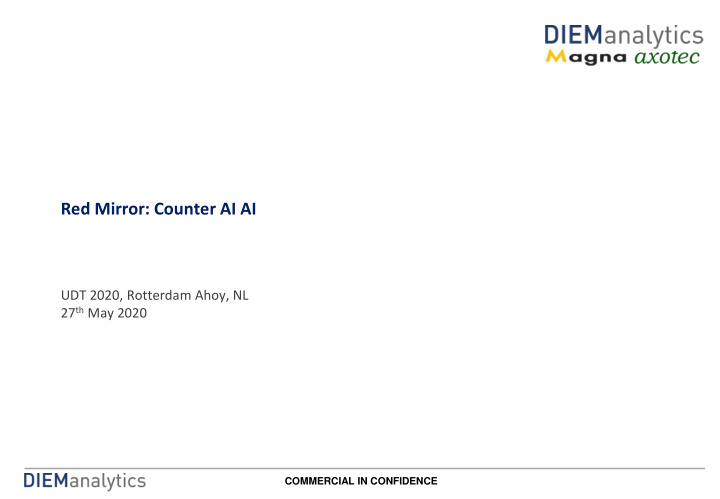



Red Mirror: Counter AI AI UDT 2020, Rotterdam Ahoy, NL 27 th May 2020 COMMERCIAL IN CONFIDENCE
Agenda • Background – Genesis – Concept • Approach – Architecture – Testing – Red AIs • Results – ESRA – DR SO • Prediction accuracy • Identifying unknowns • Next steps COMMERCIAL IN CONFIDENCE Page 2
Background | Genesis • If you can explain our AI, can you predict their AI? COMMERCIAL IN CONFIDENCE Page 3
Background | Concept • Aims – Use a combination of Artificial Intelligence (AI) and Machine Learning (ML) techniques to automatically generate a ‘mirror’ of Red’s AI i.e. the AI controlling enemy vessels • Outputs – Predict Red’s next Courses Of Action (COA) – Identify what Red knows that Blue does not – Identify what Blue knows that Red does not – Suggest what Blue should do to build a better Red Mirror (incl ‘he knows we know he knows…’ effects) – Explain the Red-AI behaviour so that the Intelligent Core or human decision-maker can check whether the Red-AI may be trying to double-bluff • Potential use-cases – Turning Red’s assets into a form of ‘sensor input’ for Blue – Getting ahead of Red i.e. SUPA loop… COMMERCIAL IN CONFIDENCE Page 4
Background | Concept COMMERCIAL IN CONFIDENCE Page 5
Approach | Architecture COMMERCIAL IN CONFIDENCE Page 6
Approach | Testing • Measures of performance – Accuracy of predicting Red’s next COA • Over time/observations • By specific action • By degree – Uncertainty of prediction • By probability • By degree – Accuracy of identifying what Red knows that Blue does not – Accuracy of identifying what Red knows that Blue does not • Test cases – Different ‘ Red AIs’ • ESRA • DR SO – Knowledge • Full • Full for Red not for Blue • Full for Blue not for Red COMMERCIAL IN CONFIDENCE Page 7
Approach | Red AIs • ESRA – 1 red ship avoiding and destroying 8 blue missiles) Threat_L Bearing Speed_ No_Of_ Missile_ Type_Of Missile_ evel_Of_ _Of_Mis Of_Miss Engaged Course_Of_Action Tracks Number _Missile Missile sile ile 4 7 0.5 300 KH-35U 434 7 HK1 track 0 4 8 0.4 30 KH-35U 434 8 SK0 track 0 4 5 0.7 30 KH-31A 600 5 HK1 track 0 4 8 0.3 120 KH-35U 434 N/A Wait COMMERCIAL IN CONFIDENCE Page 8
Approach | Red AIs • DR SO – 4 Red agents chasing 1 Blue agent, around obstacles COMMERCIAL IN CONFIDENCE Page 9
Results | ESRA – prediction accuracy vs categorical outputs COMMERCIAL IN CONFIDENCE Page 10
Results | DR SO – prediction accuracy vs continuous outputs COMMERCIAL IN CONFIDENCE Page 11
Results | DR SO – confidence in prediction accuracy COMMERCIAL IN CONFIDENCE Page 12
Results | DR SO – what Blue does not know COMMERCIAL IN CONFIDENCE Page 13
Next steps • Short-term – Demonstrate the operational impact of the demonstrated prediction accuracy, and accuracy of identifying the Blue or Red unknown e.g. • How much extra time does the Blue agent get before the DR SO Red agents successfully surround or swarm it? • How much does the Blue probability of success increase against a Red AD platform using ESRA, in terms of kill probability or rate of reduction of Red stocks? – Test a ‘reverse - decision tree’ or ‘reverse random forest’ method for identifying unknown information to improve the balance between accuracy of identification and FPR – Testing methods for extracting, or back calculating, the reward structure of the Red AI, which is implicit in the Red Mirror • Medium-term – Wider project to explore some of the issues more deeply e.g. • What types of Red AI we would wish to apply the Red Mirror concept to and what benefits accrue? • How is the difficulty of predicting AI COAs driven by the COAs and the scenarios it is used in? • Why might it be correct to not use all the past observations to predict Red, and how might the threshold after which past data is useful be found? • Why might partial knowledge improve short-term prediction accuracy but worsen longer-term prediction accuracy? • How might deception be exploited in counter-AI activity? COMMERCIAL IN CONFIDENCE Page 14
Recommend
More recommend